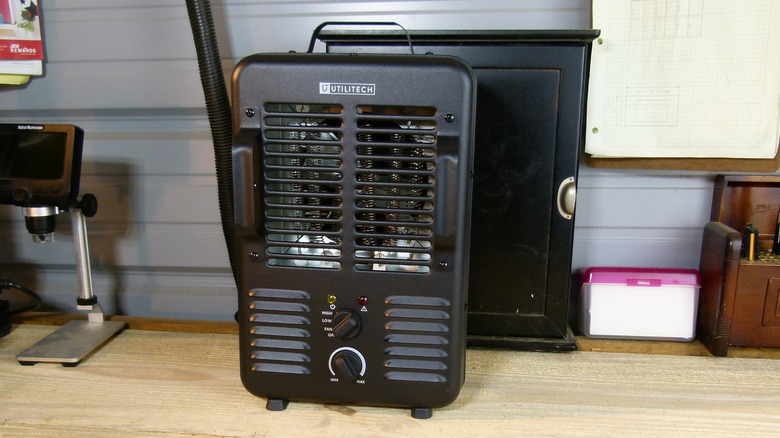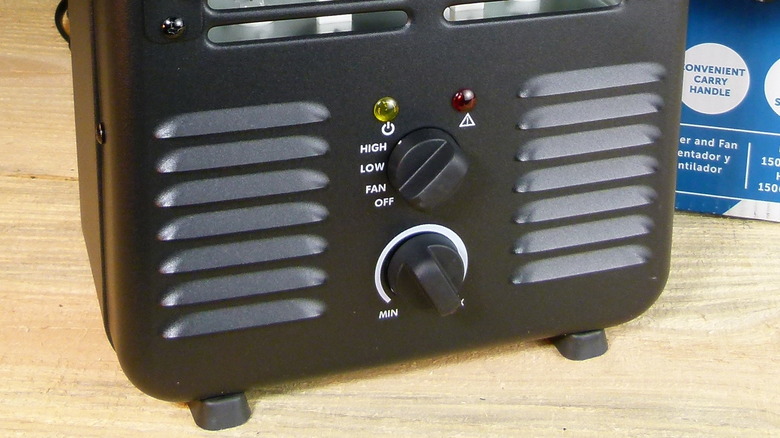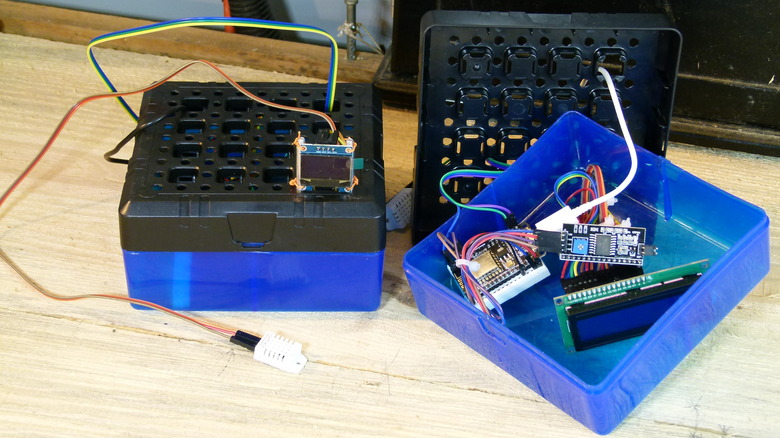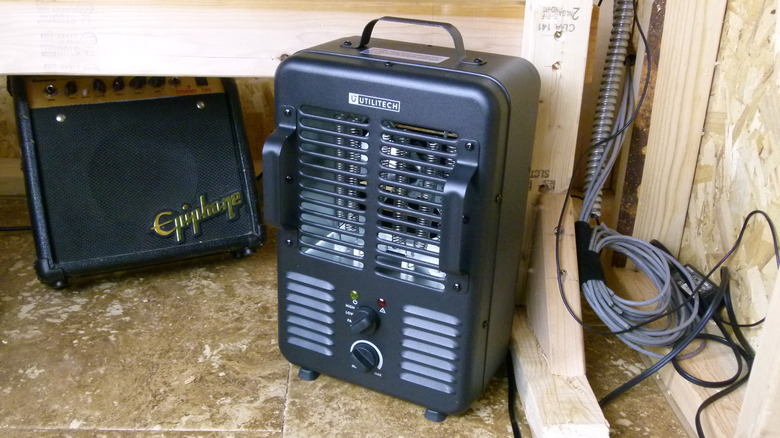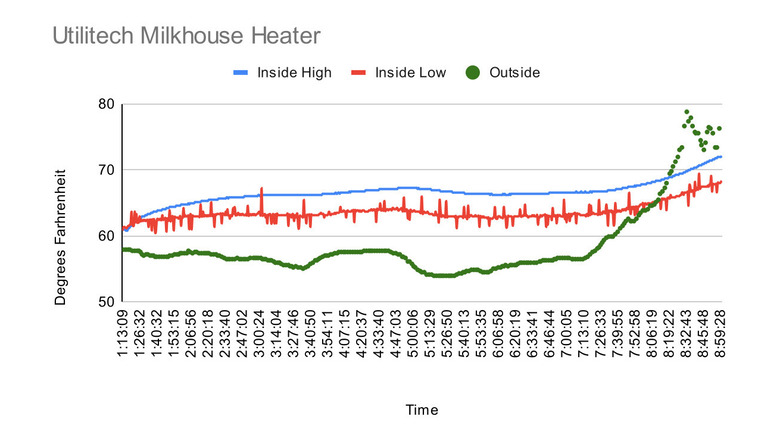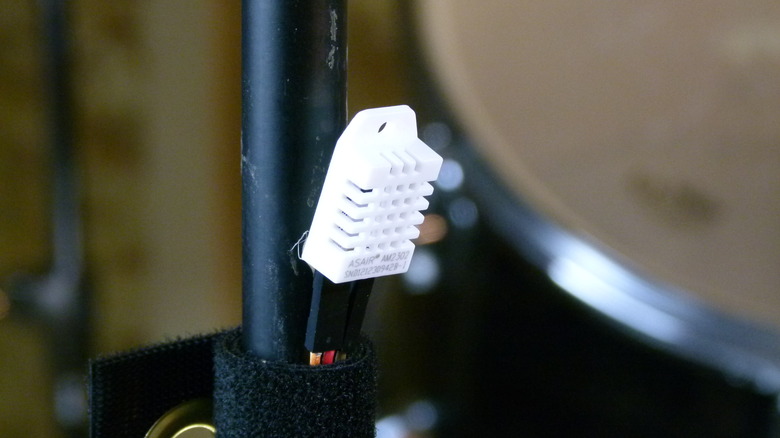We Tried The Cheapest Space Heater At Lowe's. Here's How It Went
Buying an electric fan space heater is a strangely bewildering process, not because of the complexity of options, but because they're all very similar under the hood regardless of how they're dressed up. You'll be hard-pressed to find a room-sized space heater that's not rated at 1500 watts. Smaller ones won't be intended for whole rooms, and larger freestanding options are almost impossible to find because anything beyond that 1500 watt limit would require a 20-amp circuit and a special receptacle.
Of course, the return process only matters if you can buy a thing to begin with, and it's not unusual for items to be out of stock when you get to a store, in defiance of what the store's website might believe deeply. So it was when we attempted to buy the Utilitech 1500-Watt Fan Compact Personal Indoor Electric Space Heater with Thermostat, twice, but were forced to instead walk away with the slightly more expensive Utilitech 1500-Watt Utility Fan Utility Indoor Electric Space Heater with Thermostat. (Utilitech is a Lowe's house brand.) Our order for the latter was canceled but the Lowe's site showed 34 in stock, so we decided to look for ourselves. But even aided by two different employees who surveyed the towering, orderly stacks of 1500-watt electric space heaters and conducted two separate jaunts to the back room, we were unable to turn one up. Since they seemed similar in terms of function and size (and name, clearly), we went with the upgrade for $29.98.
The Utilitech milkhouse electric space heater
The utility heater we bought for $29.98 is called a milkhouse heater on its packaging (as is this very similar but now discontinued Utilitech model from 2011, which we will come back to). A milkhouse is a small structure used at dairies for keeping milk cold (and, presumably, sometimes heated to keep it from freezing). What distinguishes a milkhouse heater is another mystery. Its matte black, all-metal construction certainly looks more industrial (and far better than the cheaper Utilitech). Possibly it was just the contribution of some marketing professional who liked the looks of it, or at least thought it went well with cows.
The heater couldn't be simpler, as evidenced by its 11-word description on the Lowe's website. The copy mostly gets the fundamentals right, and there are only fundamentals to deal with: two heat settings and an adjustable thermostat, rated to heat 200 square feet. There's also a fan-only mode. The thermostat is unencumbered by anything so descriptive as numbers or words, and seems to represent a continuum among a bunch of unspecified heat thresholds. (This is not unusual, and is probably the only way a device of this size can work.)
It includes a "tip-over safety switch" on the bottom of the heater that shuts the device off if it loses contact with the floor and an automatic shutoff in case of overheating. The heater is ETL listed, which means it's certified to meet the same safety standards as UL-listed products.
How we tested the Utilitech milkhouse heater
Evaluating a heater with a thermostat not keyed to known temperatures can be somewhat subjective. Without a milkhouse handy, we devised a test using an under-construction backyard music studio, an 8 x 12-foot, one-room, uninsulated affair at the moment. We set up two microcontrollers to record temperatures at two levels inside the studio and one outside, and then send the data to a web-based database. We graphed the resulting figures in Excel.
The intent was to determine how quickly the heater, set to high, could bring the small building up to 72 degrees Farhrenheit on a mild night. This wouldn't tell you much about how it would perform in a Wisconsin milkhouse, but would at least contain some information more concrete than "it was/wasn't very warm."
Contrary to the impression competing heater manufacturers cultivate, there's precious little to test in terms of energy efficiency. Electric space heaters are extremely electrically-efficient, in the sense that most or all of the electricity consumed is converted into heat. In most electrical applications, this is referred to as inefficiency because the creation of heat is considered wasted energy. (Think of a lightbulb: A hot bulb is one for which you're paying extra for the bulb to heat itself.) But electric space heaters are grotesquely inefficient in terms of the cost of keeping things warm. According to Georgia-based Tri-County Electric Membership Corporation, you can heat an 1800-square-foot house for the cost of running two 1500-watt electric space heaters.
How it exceeded expectations
A space heater isn't a very hands-on product. In fact, in spite of the "cool-touch housing" touted by the Lowe's website, it's probably best considered a hands-off product. But setting up the heater, turning it on, and maybe occasionally tweaking the temperature setting is about the extent of interaction you can expect. And this is a good thing; this is what a thermostat is for, after all.
In this regard, the milkhouse heater is what you'd expect. The controls seem to function properly. And if there's anything special about it, it might be the appearance. In a sea of plastic-louvered mediocrities, this little heater does have a unique and rustic charm to it. But, then, it's not really unique.
In fact, it turns out that a "milkhouse heater" is not just a thing that exists in the world, but most of the time it's a thing that looks just like the Utilitech. Consider this peek into the milk industry: Talon Juper, writing in the Cattle vertical at Farming Base (because where else would someone named Talon Juper be writing?), lists the six best milkhouse heaters for 2022 ... of which all six are either extremely similar or practically identical to the Utilitech. Nostalgia and powder coating have their uses, but there's nothing inherently milkhouse-ish about this design versus the plastic mediocrities. It just looks good. And since the five Farming Base winners that are still available cost an average of $54.74, the Utilitech is a steal ... if it heats properly.
How it could be improved
Alas, it doesn't heat properly. In fact, though we didn't do a control run with no heater to see what would happen by comparison, it's pretty safe to assume that the result wouldn't be dramatically different. Over the course of almost eight hours (738 data points), the two inside temperature sensors (one at about ankle level and one at waist level) mirrored each other with a slight difference in temperature, rising and falling together. Compared with the temperatures from the outside sensor, you can see that the heater managed to warm the building slightly as temperatures fell overnight. But the effect is relatively small, given how similar the inside and outside temperatures were.
If it had been a freezing night and we had aimed for 72 degrees inside, even a very good heater might have struggled in an uninsulated timber frame building with no interior walls. But the initial temperature difference was only about 3.4 degrees. The biggest difference during the night was about 13 degrees, but there's no way to know how much of that was simply the thermal mass of the building and its contents, but some of it surely was.
After dawn, the outside readings get erratic, probably attributable to the fact that the outside sensor was set off the ground on an improvised stand in the form of an upended black plastic dustpan; this no doubt absorbed heat and caused the wacky readings after dawn (at 7:11 a.m.).
There may be better options for heating your space
Without more context, you might not be able to conclude much from this, but the following night (which was colder), we took a few readings in the building using a Lasko 1500-watt heater. The two situations aren't strictly comparable; the second was a ceramic heater, and with the temperature difference (13 degrees for the Lasko vs. 3 degrees for the Utilitech) it had more of an uphill climb. But within an hour it achieved an 8-degree increase, while the Utilitech only managed 4.5 degrees.
Reaching an extreme conclusion is usually a good indicator that you should seek opinions to the contrary, and with products that usually means looking through reviews. The heater has a single rating on the Lowe's website: five stars, the product not recommended, and no review. This is where that very similar 2011 model comes into play. It's clearly a different product, at least in terms of superficial design elements, but the specifications, functions and controls are all identical. 37% of its reviewers awarded one star and no recommendations. Among the reviews you'll read comments like "good design, bad product," "warm air at best," and "just seems to make alot [sic] of noise and does little."
Ultimately, it's hard to conclude that the milkhouse heater might actually be best suited for a milkhouse, where staving off freezing temperatures is more important than actual warmth. Unfortunately, this isn't a goal most of us have for our homes.
